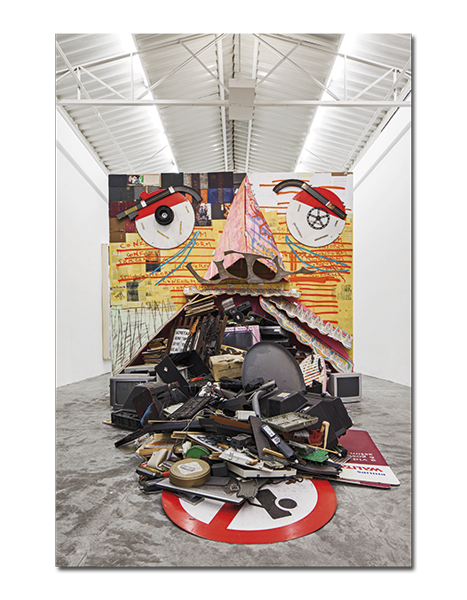 |
Curated by Ric Kasini KadourEach print issue of Kolaj Magazine presents an Exhibition-in-Print as a means of exploring critical ideas about collage. We examine work related to a curatorial premise, identify themes and ideas. The purpose is to develop and share an understanding of collage as a medium and a genre. "The Face in Collage" originally appeared in Kolaj #10. Enjoy! |
 |
The fusiform facial area is a special part of the brain that allows you to recognize faces. It is a powerful part of the brain’s visual system. So powerful, in fact, it’s hard to interfere with it. It’s also why we see Jesus in toast. And why we so easily recognize Pablo Picasso’s faces for what they are. (The neurological study of functional localization and cortical activation is a fascinating examination of how all this works, but entirely out of the scope of this article.) The face is a reoccurring image in art and an important part of the visual landscape. It appears everywhere from ancient Egyptian art to modern, to portraits throughout the centuries, to contemporary, abstract work in modern times. Sometimes the face appears to tell us who a subject is. Other times, the identity is irrelevant and the face is there to express feelings. The face easily conveys emotions and humanity. The circular “O” of Edvard Munch’s The Scream conveys a sense of terror; the tired eyes and pert mouth of the barmaid in Edouard Manet’s A Bar at the Folies-Bergère tells us about her weariness; the smirk of Leonardo da Vinci’s Mona Lisa is debatable: Is she laughing at the artist or is she confident in her knowledge or does she simply lack teeth? The face is as much a subject as it is a tool with which the artist communicates. |
As with any media or genre, the face is prevalent in collage. When artists are using fragments as paint, as is the case with artists like Benon Lutaaya and Raven Skye McDonough, the face is rendered in a manner similar to painting. But when artists are wielding collage as a tool, creating images that can only be created through the blending and juxtaposition of images, numerous strategies are used with varying results. When the face is the subject, collage allows artists to pack an image with complex narratives, emotional intricacy, and powerful statements. The images can be subtle gestures, aggressive manipulations, violent interruptions, or simply disorienting. What follows is a survey of ten collages and a discussion of their varying approaches. |
Geoffrey Wonnacott
|
DUALITY
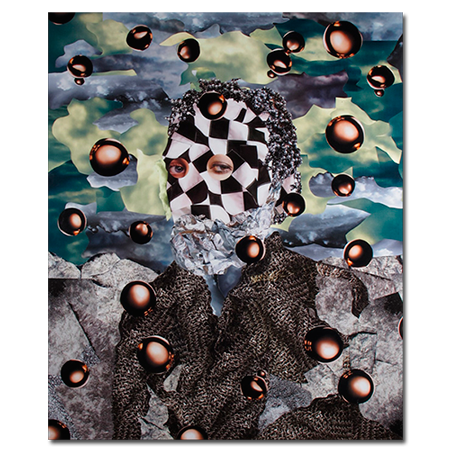
Self Portrait as my Dead Uncle by Geoffrey Wonnacott
Geoffrey Wonnacott’s Self-Portrait as my Dead Uncle is a classic, three-quarter view portrait rendered in magazine clippings. The work speaks to collage’s ability to convey duality. The title of the collage drives a number of themes in the piece. The subject’s face is covered by a checkered pattern that suggests, given the title, a death mask for the uncle and a loss of identity for the artist. Almost gone astray in the image is the shiny steel wool-like hair and tin foil-like beard of the subject that contrast so slightly that these elements nearly blend into the dynamic cloud-cut composition in the background and the chain-link coat of the body. It is as if the artist has lost himself, as if the uncle is fading from the world. The eyes allow the face to be recognized for what it is, but these, coming from different sources, highlight that the face in question is from two different people. If the title raises questions about identity and the death of a relative, the collage offers a difficult answer: The death of a loved one is like losing a part of oneself. And while they are a part of us, we are a little less ourselves. |
CONTRAST & COMPARE
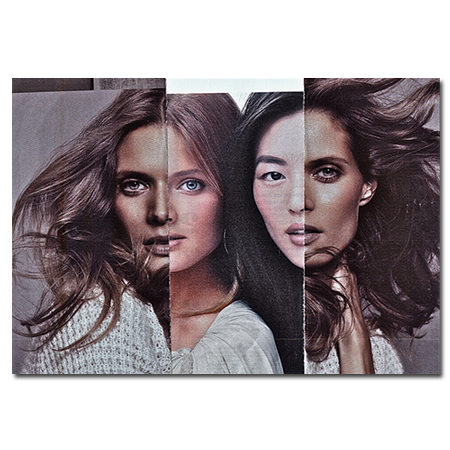
Untitled by Joaquín Sáenz Rojo
From the series “Girls on Paper,” this piece by Joaquín Sáenz Rojo is a minimal-effort collage in the spirit of John Stezaker. But where Stezaker’s collages play with notions of iconic pop culture, Sáenz Rojo investigates ideas of beauty. “From magazines and posters, I pull out portraits of models,” he explained his process. “By playing with the combinations separately, fascinating and funny, imperfect new faces full of beauty appear by chance.” Here we see the result of the artist’s mix-and-match play. The untitled collage shows the faces of two women constructed from two magazine images. Reading the faces from left to right, the eye is interrupted by contrasting racial features and yet comforted by a strikingly similar standard of beauty: smooth complexions, dilated pupils, defined bone structures, and flowing hair. |
PACKED STORIES
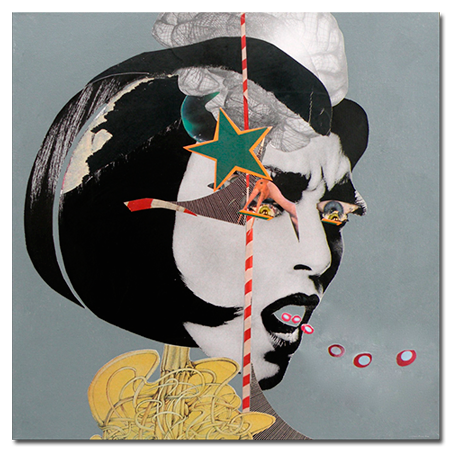
Mixed Emotions by Marian Williams
Marian Williams’ reconstruction of a face demonstrates collage’s ability to pack stories into a work of art. An angry women’s head is suspended on a spaghetti and stick body. Red bubbles flow through her open mouth. A striped pole runs down her face, adorned with a star. A bird appears through a cut in her nasal bridge. The woman’s eyes are doubled. A brain emerges from her fractured head. The seemingly random assortment of images trade in the absurd and the kitsch, but rally together to produce an image that, while simultaneously violent and broken, raises all sorts of questions that form a deeper narrative: What is the woman looking at? What happened to her body? Why is she spitting bubbles? Why is there a bird on her face? To whom is her ire directed? How will she recover? With the questions raised by the image, Williams succeeds in conveying the confusion of mixed emotions.
|
RECONSTRUCTION
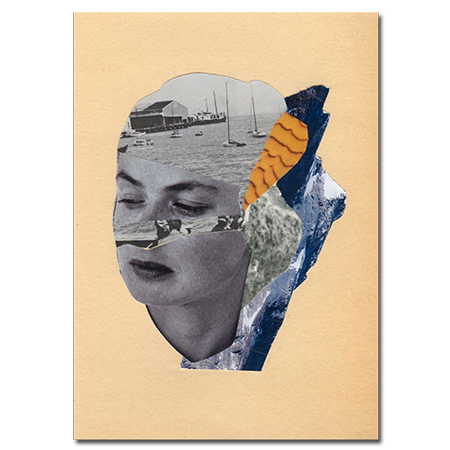
Leftovers by Michael Church
Leftovers is the reconstruction of a woman’s face using images of a harbor and pier and a mountain for hair. The woman’s eyes and mouth remain untouched. The result is a more complex image that incorporates the textures of the new imagery, a strategy used by many collage artists and increasingly used by contemporary painters.
Church explained that he is “addicted to the process of finding lost images and then reimagining the form.” His collages are reconstructions of images, revisualized with new textures and components, but in keeping with their original form. |
MANIPULATING THE MANIPULATION
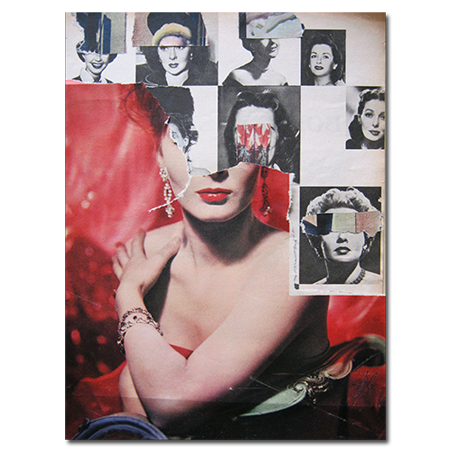
Hollywood Muse by Susan Wicker
Hollywood uses a complex set of visual strategies to glamourize and promote young female actors. As entertainment culture moved from radio to film and television, the body and the face became tools with which actresses asserted themselves and production companies exploited. Glamour shots convey the power and success of the actor which reinforce their brand and value, but these images are often tempered with a sense of open sexuality and a vulnerability that made the actor accessible to an audience. In Hollywood Muse, Wicker plays with this imagery by interrupting the faces of starlets with fragments of paper. The eyes of a blond women are covered with a strip of paper and yet, her chin asserts a sense pride. By contrast, by covering the eyes and head of the smiling woman in the top left corner, Wicker suggests a deeper loss of identity and perhaps some hidden pain. A different forehead is grafted onto the next woman in a manner that implies a different internal life than the one she projects externally, or perhaps that she is not in control of her own faculties. A women whose eyes, nose, and mouth are covered by a red and white curtain exists in anonymity. In reality, the viewer is left to ponder what exactly is going on with these women. Are they happy? Are they sad? Are they weak or powerful? The answer is unknown. In all of these faces, we see collage’s ability to interrupt facial recognition in a way that complicates the viewer’s emotional reading of the visual language.
|
COMPLEXITY
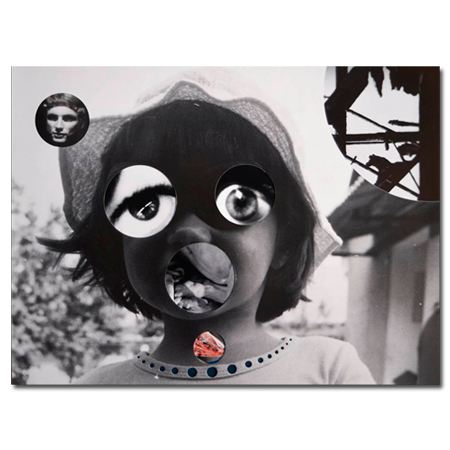
It Is a Wise Child That Knows His Own Father by Bara Jichova
This work demonstrates how the simple intervention of collage can convey complicated emotional states. The black & white photograph of a sunhat-adorned child is both funny and disturbing. The bulging eyes are so reminiscent of an old cartoon eye pop trope that one can almost hear an aooga horn in the background. A curled, disfigured body lies inside the mouth. A disembodied head hovers like a thought bubble. This play of astonishment and emotional pain; absurdity, humour, and difficult subjects are hallmarks of Jichova’s work. The title, It Is a Wise Child That Knows His Own Father, is a reference to an early moment in Homer’s Odyssey when Telemachus, the son of Ulysses, bemoans the lack of information about his father who had been away for many years and the state of his father’s household, which is being wrecked by suitors who have moved in to woo his mother. Telemachus, like the child in this collage, struggles to confront harsh truths about the world and his family’s place in it. |
COVERING
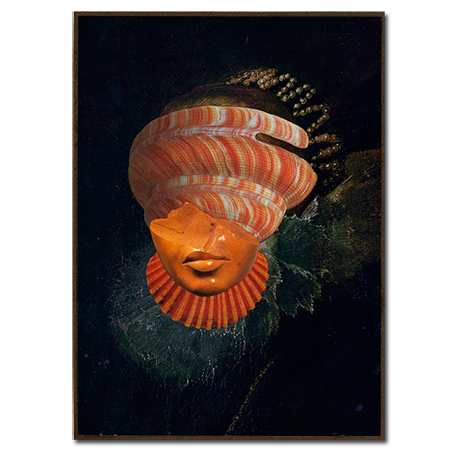
Glimmen by Doug Stapleton Stapleton uses fragments of art history, snippets of old paintings and sculptures, to craft new images. The power of his work comes from the recycling of source imagery that may be familiar to the viewer. In Glimmen, he starts with Anthony Van Dyck’s Portrait of the Marchesa Geronima Spinola. He covers the marchesa’s head with a fragment of Egyptian sculpture from the Amarna Period and the image of a shell from the 1968 book, The Shell: Five Hundred Million Years of Inspired Design by Hugh and Marguerite Stix and R. Tucker Abbott. Sometimes we cover our face for protection, sometimes we cover our face out of shame. A hand over the mouth can convey shock or surprise. Media often places a black bar across the eyes of a person to protect their anonymity. All this suggests that a covered face has meaning. In Glimmen, which is a Dutch word that means to glow or shine, Stapleton covers the glowing, rosy cheeks of the marchesa with fragments of natural and human history. The result is a layered work that asks the viewer to ponder the identity of the subject. |
INTERRUPTION & NARRATIVE
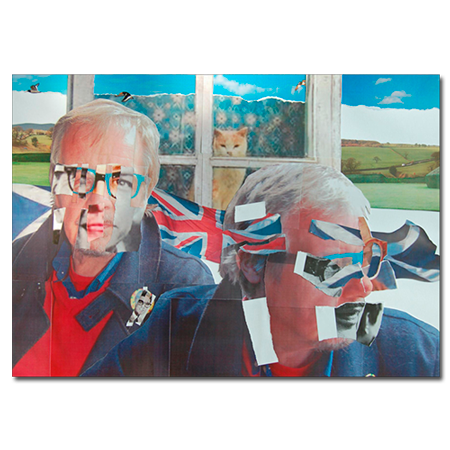
Self-Portrait with Blue (Scottish) Glasses by Cameron Scott
Scott collages photographs of himself with found images as a way of engaging in autobiographical reflection. While he sometimes will collage his face with “people he has met, hated, admired, or married,” in this case, he uses blue eyeglasses and the Union Jack as a way of exploring feelings relating to the Scottish quest for independence. Self-Portrait with Blue (Scottish) Glasses speaks to collage’s ability to interrupt the narrative in an image and introduce different, sometimes competing ideas. |
REMOVAL
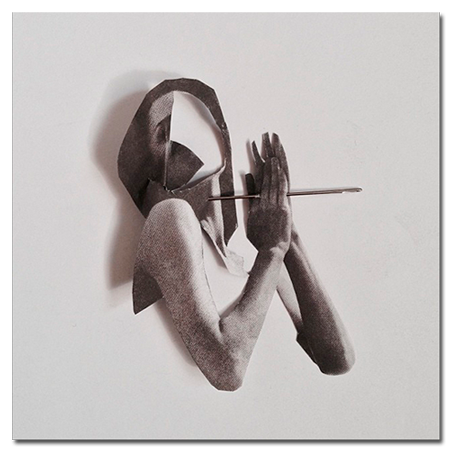
#57967 by Najeebah Al-Ghadban
When something is said to be faceless, it means that it is impersonal, remote, or anonymous, but to remove a face is an act of destruction that cuts deep into the human psyche. #57967 is from a series of ephemeral collages Kuwait-born Al-Ghadban made by cutting and arranging images which she then photographed and posted to Instagram. The result were collages with a sense of object-ness where the “glue” was the photograph. Titled “White Asylum,” the series expressed “the vulnerability of human emotions, relying primarily on shadows and industrial tools to emphasize the discordance between expressions of heart and entrapment of mind.”
#57967 is a simple gesture that presents the cut-out of a bust and arms of a woman whose face has been partially removed and folded over. Al-Ghadban puts a needle in the woman’s hands and points it at her neck. The simple gesture because a powerful image of self-harm and loss of identity. |
DISORIENTATION
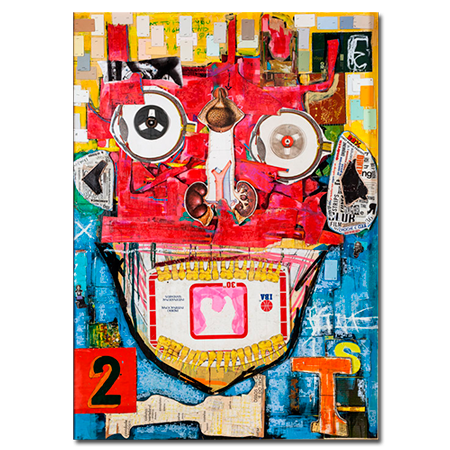
a cara da reprovaçao by Sesper
Collage has a unique ability to disturb or unsettle the viewer. Sesper’s a cara da reprovaçao presents an image of a face assembled from various parts: analog tape wheels for eyes, cut out images of lungs for nose, assorted paper fragments for the ears and mouth. Sesper is a Brazilian artist who floats between DJ, DIY, skateboard and punk scenes. In his collage work, he assembles discarded materials into simple images that suggest an almost art brut style. “Simulacrum and original are fused to compose scenes of a society self-disoriented by psychoactive substances, short-circuited ideologies, Catholic guilt, and branding,” he wrote. Layered and painted, a face emerges. In his collage installation shown at the “reprovada” exhibition at Galeria Logo (image at introduction), Sesper breaks into the third dimension as old media equipment—televisions, radios, keyboards, a satellite dish, etc—flows from the mouth of the face. While the viewer’s eye sees a collection of random images, the mind understands this as a face because it is looking to make sense of what it is seeing. Because the mind must work to put together the face from the pieces, the viewer experiences these images as disorienting, confused, or violent. |
One of the great forethinkers of surrealism, Pierre Reverdy, theorized in 1918 that an image is most powerful when it brings together two realities. His thinking was that two images coming together feed off each other, and produce a greater poetry. “An image is not strong because it is brutal or fantastic, but because the association of ideas is distant and just. The accuracy of the association is the immediate result,” wrote Reverdy. “One does not create an image by comparing two disproportionate realities. On the contrary, an image is created by bringing together two distant realities. The mind must grasp and taste without mixing the new creation.” The new image creates a new relationship between the existing realities. That is the poetry of surrealism and the starting point for the collage in this survey. But as we see, collages of the face have the ability to take things to the next level. By interfering with the mind’s powerful desire and ability to recognize the face, these collages allow complex emotional dynamics to play out in the images: thick narratives, dual meanings, deep and open questions.
|
Thank you for viewing "The Face in Collage"Kolaj Magazine presents Exhibitions-in-Print as a means of exploring critical ideas about collage by examining work related to a curatorial premise. The purpose is to develop and share an understanding of collage as a medium and a genre. "The Face in Collage" originally appeared in Kolaj #10. Join the Kolaj Magazine Artist Directory || Call to Artists About Kolaj MagazineKolaj Magazine is a quarterly, printed magazine about contemporary collage. We are interested in how collage is made, how collage is exhibited, and how collage is collected. We are interested in the role collage plays in contemporary visual culture. We provide quality exposure for contemporary collage art. This full colour, internationally-oriented art magazine. |
